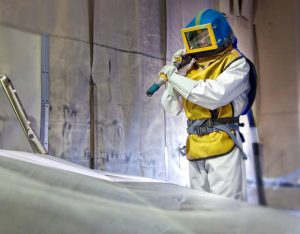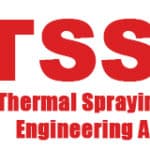Metal Coatings – How can they help you?
Thermal Metal Spraying
What it is thermal metal spraying?
Thermal spraying is a surface coating process that sprays metals, ceramics, and polymers onto the surface of another material.
Thermal metal spraying has long been used in the protective coating industry particularly in the oil and gas sector. Our course has been specifically developed to assist in understanding types of thermal metal spray and improve the hand skills of Applicators.

It’s widely used to provide corrosion protection to ferrous metals, as well as to change the item’s surface properties, for instance, to improve the wear resistance or thermal conductivity.
Corrosion and wear are a major problem for a long list of industries, so many use a metal spraying process, including:
- Offshore
- Oil and gas
- Marine
- Tube, pipe, and general fabrication
- Petrochemical
- Construction
- Water supply
- Sewerage
- Ship building
- Aerospace
- Airside support
Thermal spraying protects and extends the life of structures, equipment and vessels in many hostile environments and situations, where protective surface coatings are vital for longevity. Many will not require their first maintenance of the coating before 20 years’ service, even in harsh environments. This leads to significant maintenance cost reductions.
How does metal spraying work?
Thermal spraying for corrosion control is usually carried out by Flame and Arc spray – they are the least costly and quickest to implement, so are suitable for corrosion protection of larger structures. Plasma and HVOF sprays are used to apply engineering coatings and are of higher quality, density, and bond strength.
Sprayed metal should be applied using the oxygen/fuel gas process or electric arc process. The sprayed metal coating should be continuously applied to each 0.5 m2 of the run or the area of the component, whichever is the lesser, until the specified thickness has been achieved.
The application of sprayed metal coatings should only be carried out by a specialist Contractor who has skilled and accredited personnel to ISO 14918:2018 Thermal spraying Qualification testing of thermal sprayers. To attain this level of accreditation, we have a training provider who can offer a range of training options, and support users with all their material and consumable requirements.
Inspection personnel for thermal metal spraying should also be qualified as a Thermal Metal Spraying Inspector provided by The Thermal Spraying and Surface Engineering Association (TSSEA) or equivalent.

Benefits of Thermal Metal Spraying
Metal spraying offers several benefits, including:
- Increased durability
- Modified electrical properties
- Increased or decreased corrosion protection
- Increased hardness
- Increased or decreased friction
- Increased wear resistance
- Additional protection to damaged materials
In conclusion, one of the main reasons why this technique is so popular and widely utilised, is the deposition rate of the surface is faster and easier than any other coating processes.
To discover more about the benefits of Thermal Metal Spraying and how this method of corrosion protection is used in the protective coating industry, take a look at our Thermal Metal Spraying Applicator courses. In addition, browse our Coating Inspection courses if you are looking to take that next step in the coating industry.

